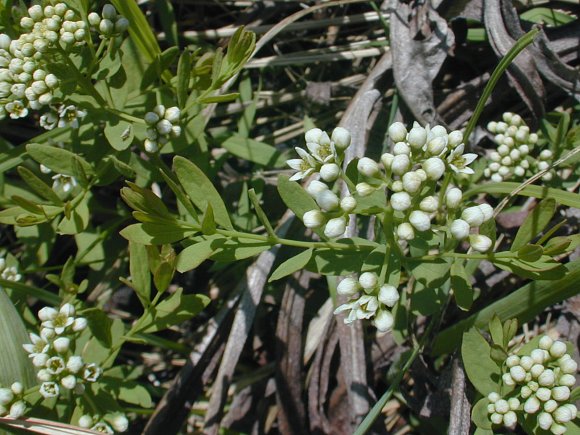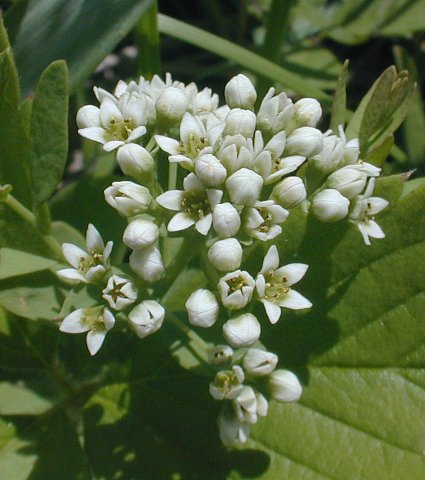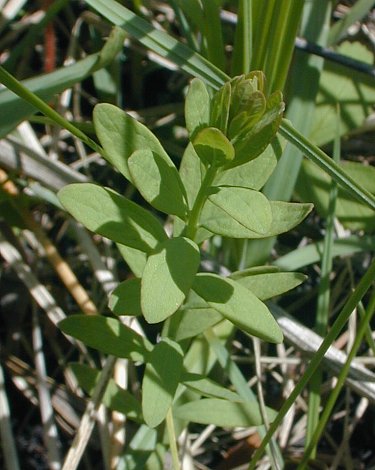Description: This herbaceous perennial plant is up to 1' tall; its leafy stems are either unbranched or sparingly branched. The stems are light green or light reddish green, terete, and glabrous. Abundant alternate leaves occur along the entire length of each stem. These leaves are ¾–1½" long, ¼–½" across, and either sessile or short-petiolate; they are oblong-elliptic to broadly oblong-elliptic in shape and their margins are entire (toothless). The upper leaf surface is grayish green and glabrous, while the lower leaf surface is slightly more pale and glabrous. Leaf venation is pinnate. Some of the stems terminate in flat-topped clusters of white flowers spanning ¾–1½" across. Sometimes these flowers are tinted green or pink. Each flower is about ¼" across, consisting of a shallow bell-shaped corolla with 5 sepals (rarely 4), 5 short stamens, and an inferior ovary with a single short style. The sepals are lanceolate in shape with spreading tips when a flower is fully open.

The central stalk, branches, and pedicels of each inflorescence are light green to light reddish green, terete, and glabrous. Individual pedicels are up to ¼" long. The blooming period occurs from late spring to early summer, lasting about 1 month for a colony of plants. Usually, relatively few flowers are in bloom at the same time in each inflorescence. There is no noticeable floral scent. Afterwards, the flowers are replaced by small oily drupes spanning about ¼" across. Each thin-fleshed drupe contains a single large seed that is globoid in shape. The drupes gradually change color from green to brown, and they are said to have a sweet taste while still immature. The root system is fibrous and long-rhizomatous. Colonies of clonal plants are often produced by the thick woody rhizomes. The fibrous roots send out underground suckers (haustoria) that parasitize other plants. As a result, Bastard Toadflax is hemiparasitic.

Cultivation:
The preference is full or partial sun, mesic to dry conditions, and an
acidic to neutral soil containing loam, sand, or rocky material. This
plant is an alternate host of Comandra Blister Rust (Cronartium comandrae).
This fungal disease also attacks hard pines (Pinus spp.).
Bastard Toadflax is
partially parasitic on the root systems of a wide variety of plants,
including grasses, forbs, shrubs, and trees.
Range & Habitat:
The native Bastard Toadflax occurs occasionally in most areas of
Illinois, but it is less common in the southern section of the state
(see Distribution
Map). This plant can be locally abundant at some high quality
sites. Habitats include black soil prairies,
sand prairies, hill prairies, rocky open woodlands, thinly wooded
ridges, sandy savannas, and barren areas with scrubby vegetation.
Bastard Toadflax is usually found in higher quality natural areas with
other native plants.
Populations of this plant tend to increase when they are exposed to
occasional wildfires or light to moderate grazing.

Faunal Associations: The nectar and pollen of the flowers attract Halictid bees (Lasioglossum spp.), Andrenid bees (Andrena spp.), soldier flies (Stratiomyidae), Syrphid flies, flesh flies (Sarcophagidae), Calliphorid flies, and Muscid flies. Less common floral visitors include various long-tongued bees, butterflies, and beetles (Robertson, 1929). The larvae of a moth, the Ochre-patched Epermeniid (Ochromolopis ramapoella), feed on the fruits of Bastard Toadflax. Other insects feeding on this plant include the polyphagous larvae of such Tortricid moths as the Oblique-banded Leafroller Moth (Choristoneura rosaceana), the Sparganothis Fruitworm (Sparganothis sulfureana), and the Pallid Leafroller Moth (Xenostemna pallorana); see Godfrey et al. (1987). It has been reported that the small oily fruits are eaten by birds and rodents (Hedgcock & Long, 1915; Mielke, 1957). Such animals may carry the fruits and their seeds for considerable distances, introducing this plant to new areas.

Photographic
Location:
The photographs were taken at the Loda Cemetery Prairie in the
southwest corner of Iroquois County, Illinois.
Comments:
This is one of the few herbaceous plants of the prairie that produces
edible fruits, although they are thin-fleshed and small in size. With
age, the flesh of these fruits becomes dry. Because Bastard Toadflax
(Comandra umbellata)
is the only member of its genus that occurs in
Illinois, it is relatively distinct in appearance and easy to identify.
Some small-flowered chickweeds (Stellaria
spp., Cerastium
spp.)
superficially resemble Bastard Toadflax, but they can be distinguished
by the notched petals of their flowers and their foliage is often
pubescent. A prairie species, Flowering Spurge (Euphorbia corolla),
has
superficially similar leafy stems while it is still young, but this
species becomes taller later in the year and it also blooms later.
While the foliage of Bastard Toadflax has clear sap, the foliage of
Flowering Spurge has milky sap, like many other spurges (Euphorbia
spp.).